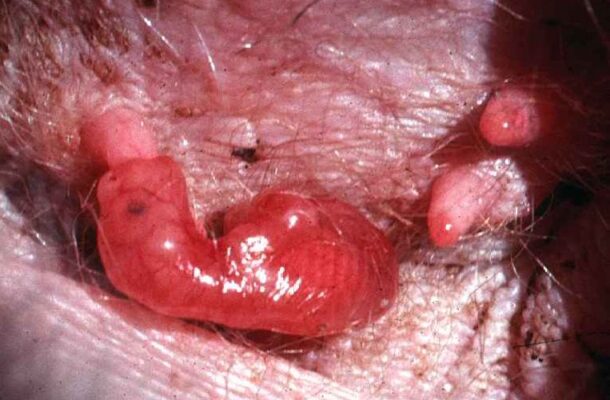How do newborn marsupials survive?

Marsupials are one of three groups of mammals, the other two groups being the eutherians or ‘placentals’, and the egg-laying monotremes.
Marsupials are differentiated from eutherians as marsupials are born after a short gestation period, in which very limited organ development occurs, and hence a significant portion of their development occurs in the external environment after birth.
The shortest gestation period reported to date of all mammals is that of the stripe-faced dunnart (Sminthopsis macroura) at 10.7 days, of which only 1.5 days are utilised for organ development. Unlike eutherian mammals, neonatal marsupials are therefore born much smaller in size and weight relative to maternal size.
The smallest ningaui (Ningaui spp.) gives birth to young weighing 13mg, whilst the largest living marsupial, the red kangaroo (Osphranter rufus) gives birth to a whopping 400 mg neonate.
Marsupials are therefore understandably born not just smaller but also much less developed than their eutherian counterparts. The developmental stage of the newborn opossum (Didelphis virginiana) has been described as equivalent to an eight-week-old human foetus, and as such it is largely assumed that in terms of development, the time of ‘pouch emergence’ is equivalent to the developmental stage of eutherians at birth.
An epic journey
How neonatal marsupials can travel to the teat and attach is therefore quite astounding! Given their lack of development at birth, how can marsupial neonates transit from the urogenital opening to the maternal teat and amazingly survive?
Marsupial neonates must have key anatomical structures sufficiently developed to make this epic journey from the vagina to the pouch. They must be able to determine the direction in which to travel and have developed sufficient neuromuscular coordination to be able to physically climb from the urogenital opening to the teat, attach and suckle. They need to fuel the muscles, and to obtain adequate oxygen for those muscles.
In some species this journey is even more time critical than others, as some marsupials give birth to supernumerary young, thus not only is it a fight for survival to make it to the teat and permanently attach, but it is complicated by the need to get to a teat before their siblings. The number of teats available, limit the number of young that can be sustained, and any neonates not able to locate and attach simply perish.
A mother’s help
To support the newborn on its journey, marsupial mothers have been observed to adopt a birth posture and exhibit specific patterns of behaviour, and this birth posture is influenced by the position of the teats and pouch. Marsupials with forward-facing pouches, such as the macropods, position themselves by sitting on the base of their tail, with their tail resting between their hind legs or behind their body.
Marsupials with backwards facing pouches, such as bandicoots, Peramelemorphia, lay on one side with one leg raised, steadying themselves with their front feet, whilst their head is twisted to the rear, resulting in a reduced travelling distance between the urogenital opening and the pouch.
Others with a rudimentary pouch (or those lacking a pouch), such as the northern quoll (Dasyurus hallucatus) stand on all four legs with hips raised, positioning the urogenital opening above the pouch/teats, and allowing the neonate to travel downwards. It is thought gravity may support the neonate in these endeavours, as studies have described well developed otoliths, cilia and microcilia, thus suggesting a functional vestibular system, required for balance.
The direction the neonate travels and the method they utilise to get to the pouch are therefore dependent on the position of the pouch. Once the initial direction is determined by the neonate, it then needs to start to move towards the teat. For marsupials with forward-facing pouches, their neonates use a swimming motion, and those with backward-facing or rudimentary pouches have neonates that travel sideways or downwards in an S-shaped wriggle.
Tiny but strong
Neonates must also have functional, well-developed forelimbs and shoulders. The shoulder is cartilaginous in neonates, but they have well-developed muscles of the neck and thorax to provide forearm support and to allow movement. The forepaws are relatively robust, with sharp curved claws, providing the young with the ability to grasp the mother’s fur. In contrast, the hindlimbs, which do not play a significant role in the transit from the urogenital opening to the teat, are much less developed, shaped like paddles and lacking claws.
A temperature gradient between the urogenital opening and pouch of the northern quoll, for example, also supports the neonate to locate the pouch and teat. Hair from the urogenital opening to the pouch also forms a tunnel, thus potentially providing a direct route for the neonate to follow.
Tactile reception (touch) is also functional at birth and supports the newborn marsupial in getting to the teat. Merkel mechanoreceptors which detect sensory changes are present in the skin around the mouth of neonates. The trigeminal nerve plexus (one of the largest cranial nerves) conveys sensory information collected by the mouth, lips, and tongue to the brain, and may also be involved in coordination of sensory input, due to its proximity to motor fibres.
Except for marsupial moles (Notoryctidae spp.), all adult marsupials can see, hear, taste, smell and feel. However, neonatal marsupials are born without fully developed ears and eyes, hence they are unable to hear or see and lack a functional auditory and visual sensory system.
However, once the neonate reaches the pouch, olfaction is believed to play a role in locating the teat. The mammary gland likely plays a sensory attractant role, by providing this smell, and once the young marsupial is nearby, milk provides taste. This theory has been described for rabbits, whereby pheromones aid newborn kittens in locating the teat.
Likewise neonatal tammar wallabies (Notamacropus eugenii) can locate their mother’s odour and is presumably how they locate their mother’s milk. Furthermore, neonates can redirect their movements when they reach the edge of the pouch, and can move towards pouch scents.
Hence, a sense of smell is extremely important to neonatal marsupials, and unsurprisingly the mouth, tongue and nostrils are prominent features of newborns. They also have a well-developed olfactory apparatus and olfactory bulb which they use to detect odours.
Keep breathing
Neonatal marsupial lung tissue is immature in appearance; specifically they lack the specialised alveoli of adults. Nevertheless, neonates require gas exchange to occur when travelling to the pouch. In neonates the circulation of the lungs is not yet distinct from the rest of the body, and incomplete interventricular septation results in mixing of oxygenated blood from the lungs and deoxygenated blood from the body.
The size of the neonates also influences the respiration pathway and mechanism utilised. Smaller neonates, including the Julia Creek dunnart (Sminthopsis douglasi), utilise their skin as their main method of respiration until at least three weeks postpartum. Cutaneous respiration is much more effective in obtaining oxygen and removing carbon dioxide than the lungs, because the small size of the airway restricts air flow.
In larger neonates, including the tammar wallaby and quokka (Setonix brachyurus), cutaneous respiration is not as highly effective, but still occurs in the first week after birth. The lungs of the larger neonates however are more advanced in their development and have septae separating the air sacs, and being larger in size, air flow in and out of the airways is not as restricted.
A third method of respiration occurs in bandicoots. Their umbilicus supplies oxygen directly to the neonate whilst it travels to the pouch. The umbilicus remains attached to both the neonate, and to the placenta which does not detach from the uterus during this time. Once attached to the teat, the umbilicus then detaches, and the neonate then relies on respiration to take place in the lungs.
The lungs of newborn marsupials have been investigated. Of all the marsupials examined, dasyurids appear to have the least developed lungs at the time of birth and they are essentially vascularised air sacs.
The extremely small size and lack of development of the lungs in species such as the Julia Creek dunnart, means that breathing actions are extremely inefficient due to the resistance of the airways. In newborn dunnarts breathing is therefore sporadic and largely dependent on body movements, which suggest the respiratory centres in the brain are not yet developed.
It is not until 2 to 3 weeks after birth that regular breathing is initiated. Nevertheless, newborns have established the Hering Breuer reflex, one of the central reflexes that prevents respiratory action when the lungs are inflated. Newborn marsupial lungs also have surfactant secreting pneumocytes, and it is likely that the control and production of surfactant is like that of eutherians.
Once attached to the teat, the neonate must suckle and remain attached. The lips and tongue of the newborn must therefore be sufficiently developed to perform these functions. On reaching the teat and attaching, longer-term survival strategies are required, such as metabolism and removal of wastes, thermoregulation and immune defence.
It is truly amazing how something so immature in its development can crawl to a teat, attach and survive.
This article was written by Julie M. Old and Lauren Chappell of Western Sydney University and Hayley J. Stannard of Charles Sturt University.
Associate Professor Julie Old joined Western Sydney University in 2006 and specialises in comparative and developmental immunology, native mammal biology, wildlife management, conservation and citizen science.













